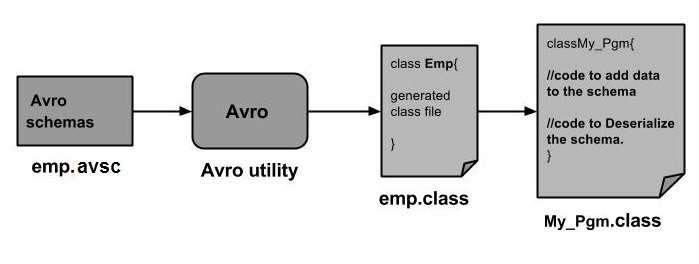
- AVRO By Generating a Class
- Serialization by Generating Class
- Deserialization by Generating Class
- AVRO Using Parsers Library
- Serialization Using Parsers
- Deserialization Using Parsers
- AVRO Useful Resources
- AVRO - Quick Guide
- AVRO - Useful Resources
- AVRO - Discussion
AVRO - Deserialization By Generating Class
As described earlier, one can read an Avro schema into a program either by generating a class corresponding to the schema or by using the parsers library. This chapter describes how to read the schema by generating a class and Deserialize the data using Avro.
Deserialization by Generating a Class
The serialized data is stored in the file emp.avro. You can deserialize and read it using Avro.

Follow the procedure given below to deserialize the serialized data from a file.
Step 1
Create an object of DatumReader interface using SpecificDatumReader class.
DatumReader<emp>empDatumReader = new SpecificDatumReader<emp>(emp.class);
Step 2
Instantiate DataFileReader for emp class. This class reads serialized data from a file. It requires the Dataumeader object, and path of the file where the serialized data is existing, as a parameters to the constructor.
DataFileReader<emp> dataFileReader = new DataFileReader(new File("/path/to/emp.avro"), empDatumReader);
Step 3
Print the deserialized data, using the methods of DataFileReader.
The hasNext() method will return a boolean if there are any elements in the Reader.
The next() method of DataFileReader returns the data in the Reader.
while(dataFileReader.hasNext()){
em=dataFileReader.next(em);
System.out.println(em);
}
Example Deserialization by Generating a Class
The following complete program shows how to deserialize the data in a file using Avro.
import java.io.File;
import java.io.IOException;
import org.apache.avro.file.DataFileReader;
import org.apache.avro.io.DatumReader;
import org.apache.avro.specific.SpecificDatumReader;
public class Deserialize {
public static void main(String args[]) throws IOException{
//DeSerializing the objects
DatumReader<emp> empDatumReader = new SpecificDatumReader<emp>(emp.class);
//Instantiating DataFileReader
DataFileReader<emp> dataFileReader = new DataFileReader<emp>(new
File("/home/Hadoop/Avro_Work/with_code_genfile/emp.avro"), empDatumReader);
emp em=null;
while(dataFileReader.hasNext()){
em=dataFileReader.next(em);
System.out.println(em);
}
}
}
Browse into the directory where the generated code is placed. In this case, at home/Hadoop/Avro_work/with_code_gen.
$ cd home/Hadoop/Avro_work/with_code_gen/
Now, copy and save the above program in the file named DeSerialize.java. Compile and execute it as shown below −
$ javac Deserialize.java $ java Deserialize
Output
{"name": "omar", "id": 1, "salary": 30000, "age": 21, "address": "Hyderabad"}
{"name": "ram", "id": 2, "salary": 40000, "age": 30, "address": "Hyderabad"}
{"name": "robbin", "id": 3, "salary": 35000, "age": 25, "address": "Hyderabad"}